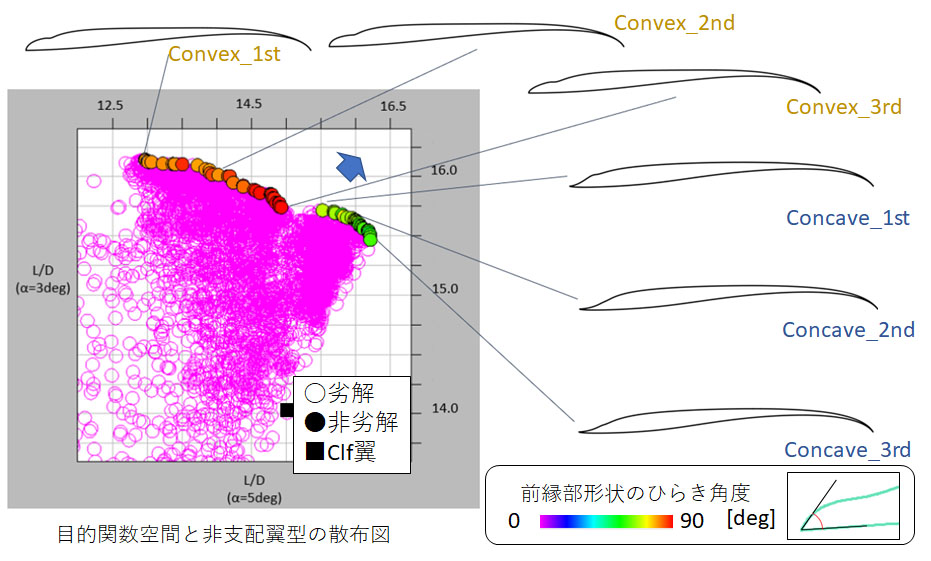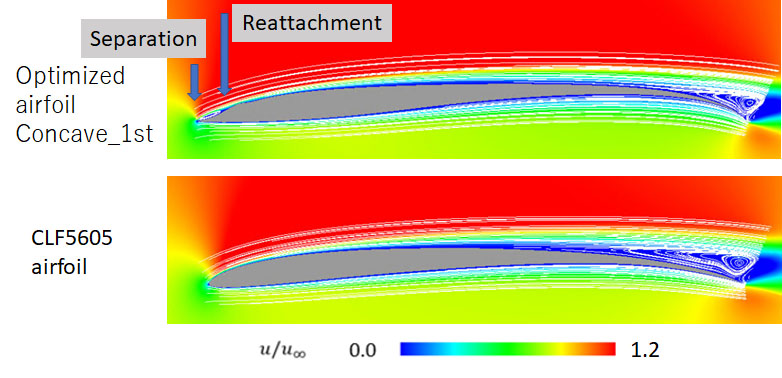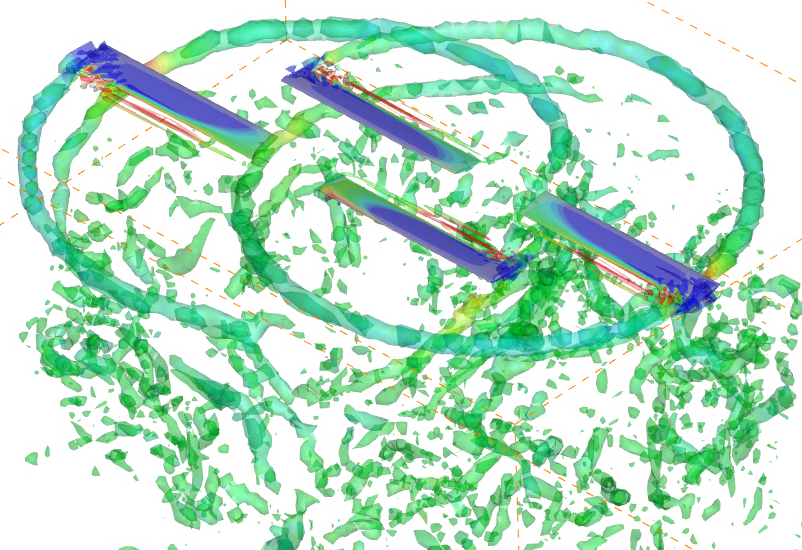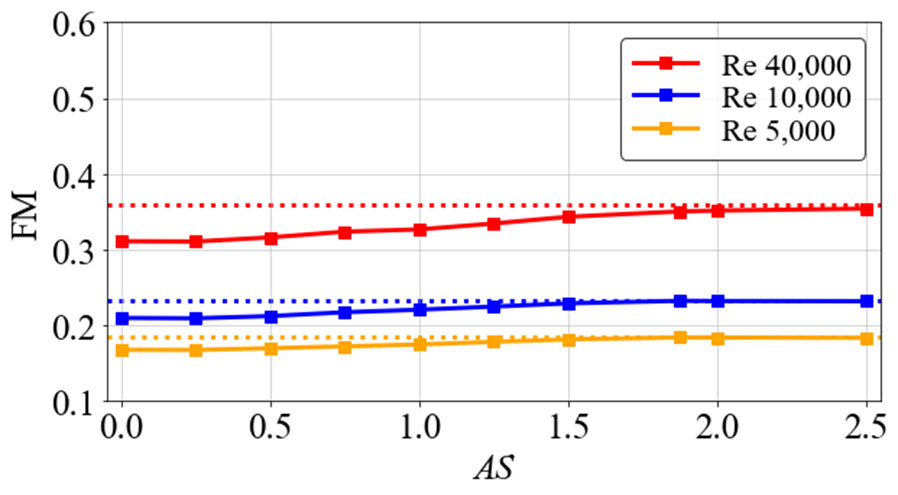Study of high speed fluid dynamics
JAXA Supercomputer System Annual Report February 2021-January 2022
Report Number: R21EU0902
Subject Category: Space and Astronautical Science
- Responsible Representative: Akira Oyama, Associate Professor, Institute of Space and Astronautical Science, JAXA
- Contact Information: Akira Oyama(oyama@flab.isas.jaxa.jp)
- Members: Shota Taniguchi, Naruhiko Nimura, Yuuki Fukushima, Kento Kaneko, Motoki Sato
Abstract
To conduct fundamental research on high-speed fluid dynamics such as aerodynamic design of Mars drones
Reference URL
Please refer to 'Akira Oyama Laboratory of Aerodynamics and Design in Space Engineering'.
Reasons and benefits of using JAXA Supercomputer System
Large eddy simulations are required for analysis of Mars drones.
Achievements of the Year
To design a rotor blade with better flight performance for pit craters' exploration of Mars by a Mars helicopter, multi-objective design optimization is performed in the design range including sharp leading edge and trailing edge shapes to design a rotor blade with higher flight performance on Mars. To evaluate the objective function, the lift-drag ratio at two angles of attack was used to account for the robustness against angle of attack. The flow fields of the obtained optimal solutions were compared with the flow field of an airfoil with good performance under low Reynolds number, and the characteristics of the airfoil were investigated. It was confirmed that the formation of the reattachment region of the separation due to the concave shape at the leading edge of the airfoil upper surface contributed to the increase in lift-drag ratio.
Reynolds number effect on aerodynamic interference of overlapping rotors is studied in low Reynolds number flow conditions. Results of three-dimensional Navier-Stokes simulations of overlapping rotors at different horizontal distance in Reynolds number of 5,000, 10,000, and 40,000 are compared. The results show that figure-of-merit (FM) decreases as Reynolds number decreases and FM monotonically decreases as horizontal distance decreases. This trend does not change for all Reynolds number conditions. FM of the overlapping rotors doesn't exceed that of the single rotor at any overlap position in the current computational conditions. The results also show that the deterioration of FM due to interference of overlapping rotors becomes smaller at Reynolds number of 10,000 and lower and it does not change if the Reynolds number is lower than 10,000. From these results, we conclude aerodynamic interference of the overlapping rotors is relatively small for the Mars drone where the expected tip Reynolds number is about 10,000.

Fig.1: Scatter plots of dominated and non-dominated solutions in the objective function space and the front edge opening angle of non-dominated solutions

Fig.2: Flow velocity distributions of optimized (top) and clf5605 (bottom) airfoils at angles of attack of 4 degrees.
Publications
- Oral Presentations
Taniguchi, Shota, and Akira Oyama. Numerical Analysis of Propeller Mounting Position Effects on Aerodynamic Propeller/Wing Interaction. AIAA SCITECH 2022 Forum. San Diego, CA & Virtual Event, 3-7 January 2022.
Fukushima, Yuki, and Akira Oyama. Aerodynamic interaction of overlapping rotors for Mars drone. AIAA SCITECH 2022 Forum. San Diego, CA & Virtual Event, 3-7 January 2022.
Usage of JSS
Computational Information
- Process Parallelization Methods: MPI
- Thread Parallelization Methods: Automatic Parallelization
- Number of Processes: 1 - 37
- Elapsed Time per Case: 350 Hour(s)
JSS3 Resources Used
Fraction of Usage in Total Resources*1(%): 1.71
Details
Please refer to System Configuration of JSS3 for the system configuration and major specifications of JSS3.
| System Name | CPU Resources Used(Core x Hours) | Fraction of Usage*2(%) |
|---|---|---|
| TOKI-SORA | 33868554.89 | 1.65 |
| TOKI-ST | 1929108.95 | 2.38 |
| TOKI-GP | 0.00 | 0.00 |
| TOKI-XM | 0.00 | 0.00 |
| TOKI-LM | 1352.73 | 0.10 |
| TOKI-TST | 2.50 | 0.00 |
| TOKI-TGP | 0.00 | 0.00 |
| TOKI-TLM | 0.00 | 0.00 |
| File System Name | Storage Assigned(GiB) | Fraction of Usage*2(%) |
|---|---|---|
| /home | 3373.67 | 3.36 |
| /data and /data2 | 132145.33 | 1.41 |
| /ssd | 11028.33 | 2.85 |
| Archiver Name | Storage Used(TiB) | Fraction of Usage*2(%) |
|---|---|---|
| J-SPACE | 19.05 | 0.13 |
*1: Fraction of Usage in Total Resources: Weighted average of three resource types (Computing, File System, and Archiver).
*2: Fraction of Usage:Percentage of usage relative to each resource used in one year.
ISV Software Licenses Used
| ISV Software Licenses Used(Hours) | Fraction of Usage*2(%) | |
|---|---|---|
| ISV Software Licenses(Total) | 1448.47 | 1.01 |
*2: Fraction of Usage:Percentage of usage relative to each resource used in one year.
JAXA Supercomputer System Annual Report February 2021-January 2022




